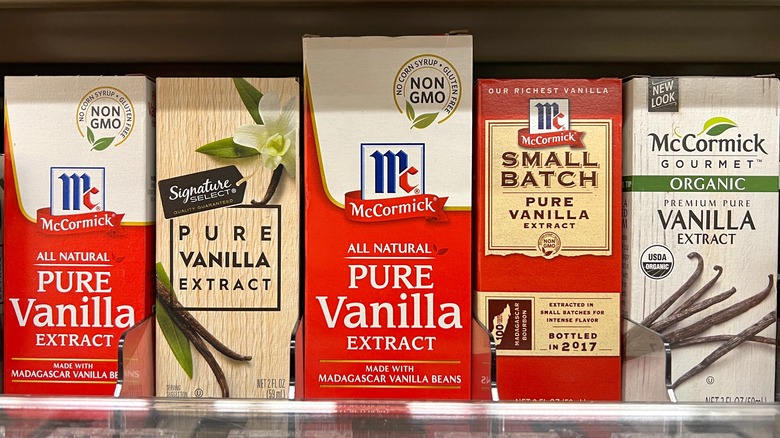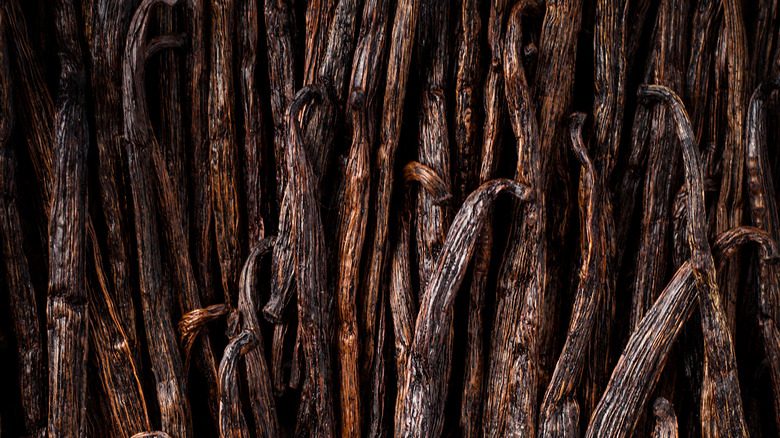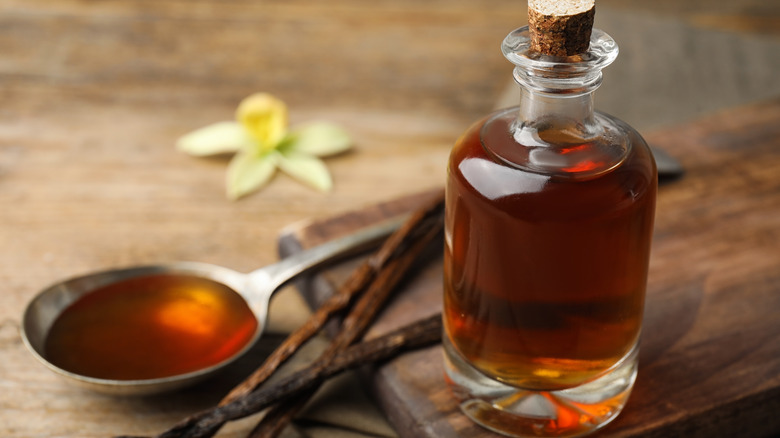What To Look For On The Label When Buying Vanilla Extract
It's a bean. It's a flower. It's a fruit. It's vanilla! The world's most popular scent according to the Smithsonian and the world's favorite flavor according to Saveur, vanilla has shaped confectionery across the globe. The popularity of vanilla has led to the production of a variety of products containing vanilla or claiming to be the real thing — extract, flavoring, paste, and flour to name a few. Then there are vanilla-scented things like candles and perfume. How is this achieved?
Vanilla is actually not a bean. The pod (or bean) is the fruit of an orchid flower from the Vanilla genus, explains Bon Appétit. The flower opens up only once a year and needs to be pollinated to produce fruit, reports Saveur. To this day, that process is done manually by vanilla farmers. Then, the pod must ripen and darken before it's harvested and dried for a month. This tedious process is a clue as to why vanilla extract can be $30 a bottle. At around $300 a pound (via Robust Kitchen), vanilla is the second most expensive spice after Saffron, according to Saveur.
Vanilla flavor comes from vanillin
The vanilla flavor that we all love is most likely the naturally occurring chemical compound "vanillin" in the vanilla pod, according to Liberate. But, vanilla has many other flavor variations depending on the region in which it's grown. Madagascar produces 80% of the world's vanilla but tropical climates like those in Mexico, South Pacific Islands, and Indonesia grow and produce it also, says Bon Appétit. Vanilla has been described as fragrant having smokey, citrus, earthy, caramel, and floral notes depending on where it's grown will determine which of those come through the most.
Vanillin can be copied and produced artificially making for a more affordable product. In fact, most of the vanillin in the world is produced synthetically (via Springer Link). This artificial vanilla extract is often called "essence" and according to Health Line is made using water, ethanol, propylene glycol, emulsifiers, and chemically produced flavors and colors.
Vanilla extract is regulated by law
True vanilla extract has a much more complicated flavor. According to Simply Organic, vanilla can have up to 200 flavor compounds. To extract the fruit's flavor, vanilla beans are soaked in water and ethyl alcohol writes Simply Organic. In fact, vanilla is the only flavor that's regulated by U.S. law. The U.S. Food and Drug Administration states that vanilla should not have an alcohol content of less than 35% by volume. While they do allow the extract to contain one or more additional ingredients, these ingredients are monitored and limited to sugar, corn syrup, glycerin, dextrose, and propylene glycol.
When looking for a superb bottle of real vanilla extract, look for simple and whole ingredients — vanilla, water, and alcohol. Avoid extracts with additives like sugar or dextrose even though allowed, writes Bon Appétit. If the cost of real vanilla extract still scares you, Simply Organic explains that you can still get real vanilla only in a flavoring (not extract) that suspends the vanilla in water and vegetable glycerin instead of alcohol. But for recipes that call for vanilla as the main flavor, Bon Appétit suggests opting for high-quality vanilla extract. It's hard to beat the real deal after all.


